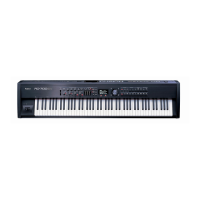89
Making Detailed Settings for Tones
Choose the Part and the Tone for which you want to make
settings.
This sets the depth of the reverb and chorus effects.
When this value is set to “0,” no reverb or chorus
effect is applied when the REVERB [DEPTH] knob
or the CHORUS [DEPTH] knob is turned.
The manner in which the effect is applied will
differ depending on the settings for the MFX Dest
(p. 117).
•
When the MFX Dest setting is ALL PART
The Reverb/Chorus Amount of the part selected
by MFX Src Zone will apply to the overall
sound.
•
When the MFX Dest setting is SAME MFX
The Reverb/Chorus Amount of the MFX Src
Zone part will apply to parts assigned to the
same MFX Type as the MFX Src Zone part.
Specifies whether the tone will play polyphonically (POLY) or
monophonically (MONO).
The MONO setting is effective when playing a solo instrument
tone such as sax or flute.
Additionally, when this is set to “MONO LEGATO,” you can
have monophonic performances played legato. Legato is a
playing style in which the spaces between notes are
smoothed, creating a flowing feel with no borders between the
notes. This creates a smooth transition between notes, which is
effective when you wish to simulate the hammering-on and
pulling-off techniques used by a guitarist.
You can make settings for the multi-effect applied to a tone.
The multi-effects are general-purpose effects that modify the
sound itself, and are able to completely transform the
character of the sound. There are 124 types of effects, and
you can choose the type that’s suitable for your purposes.
Some types consist of a single effect such as distortion or
flanger, and other types combine effects in series or in
parallel. Reverb and chorus are also provided as multi-effect
types, and these are handled independently from the Reverb
(p. 118) and Chorus (p. 118) effects described later.
The RD-700GX lets you apply two multi-effects to the tones.
The two multi-effects are connected in series.
Press the [F2] button to switch between the two multi-effects.
Depending on the MFX Dest setting, the multi-effect
you select here may not be applied in some cases.
Refer to “MFX Dest (MFX Destination)” (p. 117).
Selecting the Part and the Tone to Be
Set (Part/Tone)
Parameter
Value
Part
1–16
A part assigned to the INTERNAL zone is
shown following the part name; for example,
“(UPPER 1).”
Tone
When the part to be set is selected, the name
of the assigned tone appears.
You can select tone using the TONE SELECT
buttons.
Setting the Reverb/Chorus Depth
(Reverb Amount/Chorus Amount)
Parameter
Value
Reverb Amount
0–127
Chorus Amount
NOTE
Playing Sound Monophonically
(Mono/Poly)
Parameter
Value Description
Mono/Poly
MONO
Only the last-played note
will sound.
POLY
Two or more notes can
be played
simultaneously.
MONO LEGATO
Legato is applied to
monophonic
performances.
Changing the Effect Applied to a Tone
(MFX 1 Type/MFX 2 Type)
Parameter
Value
MFX 1
Refer to “Effect/Parameter List” (p.
154).
MFX 2
NOTE
RD-700GX_e.book 89 ページ 2008年2月13日 水曜日 午後5時49分

